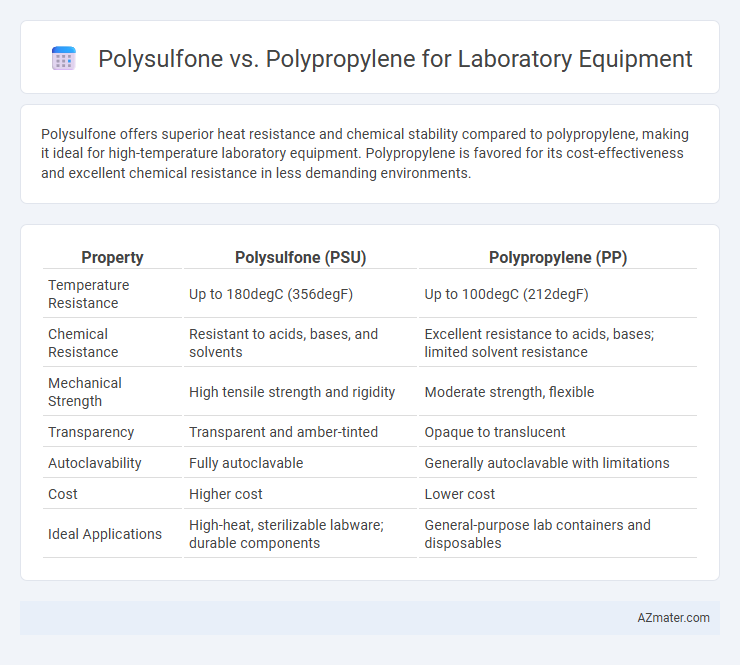Polysulfone offers superior heat resistance and chemical stability compared to polypropylene, making it ideal for high-temperature laboratory equipment. Polypropylene is favored for its cost-effectiveness and excellent chemical resistance in less demanding environments.
Table of Comparison
| Property | Polysulfone (PSU) | Polypropylene (PP) |
|---|---|---|
| Temperature Resistance | Up to 180degC (356degF) | Up to 100degC (212degF) |
| Chemical Resistance | Resistant to acids, bases, and solvents | Excellent resistance to acids, bases; limited solvent resistance |
| Mechanical Strength | High tensile strength and rigidity | Moderate strength, flexible |
| Transparency | Transparent and amber-tinted | Opaque to translucent |
| Autoclavability | Fully autoclavable | Generally autoclavable with limitations |
| Cost | Higher cost | Lower cost |
| Ideal Applications | High-heat, sterilizable labware; durable components | General-purpose lab containers and disposables |
Introduction to Polysulfone and Polypropylene
Polysulfone is a high-performance thermoplastic known for its excellent thermal stability, chemical resistance, and transparency, making it ideal for demanding laboratory applications such as filtration devices and autoclaved equipment. Polypropylene offers exceptional chemical resistance, low cost, and good mechanical properties, making it widely used for disposable labware including tubes, bottles, and centrifuge tubes. Both materials serve crucial roles in laboratory settings, with polysulfone preferred for reusable and high-temperature applications, while polypropylene suits applications requiring cost-effective and chemically resistant disposables.
Chemical Structure and Properties
Polysulfone features a robust aromatic backbone with sulfone groups, providing exceptional thermal stability and resistance to acidic and basic chemicals, making it ideal for high-performance laboratory equipment. Polypropylene, composed of simple hydrocarbon chains with methyl side groups, offers excellent chemical resistance to many solvents and acids but has lower thermal resistance compared to polysulfone. The rigid, high-temperature tolerance of polysulfone surpasses the flexible, lower-cost polypropylene, influencing material choice based on specific chemical exposure and thermal requirements in laboratory settings.
Thermal Resistance Comparison
Polysulfone exhibits superior thermal resistance, maintaining structural integrity at temperatures up to 160degC (320degF), whereas polypropylene typically withstands temperatures only up to 100degC (212degF). This makes polysulfone more suitable for laboratory equipment requiring repeated sterilization processes such as autoclaving. The enhanced heat tolerance of polysulfone reduces the risk of deformation and chemical degradation under high-temperature conditions compared to polypropylene.
Mechanical Strength and Durability
Polysulfone offers superior mechanical strength and higher temperature resistance compared to polypropylene, making it ideal for laboratory equipment subjected to repeated sterilization and thermal stress. Polypropylene, while more cost-effective and chemically resistant to a broad range of lab solvents, exhibits lower impact resistance and becomes brittle under prolonged heat exposure. Choosing polysulfone enhances durability and longevity in demanding laboratory environments where mechanical stability is critical.
Chemical Compatibility in Laboratory Settings
Polysulfone exhibits superior chemical resistance to a wide range of acids, alkalis, and organic solvents, making it highly suitable for laboratory equipment exposed to harsh chemicals. Polypropylene offers good resistance to many chemicals but is more vulnerable to strong oxidizing agents and high-temperature solvents, limiting its use in aggressive chemical environments. Choosing polysulfone over polypropylene enhances durability and safety in laboratories requiring frequent exposure to corrosive or high-temperature substances.
Sterilization Methods and Performance
Polysulfone exhibits superior thermal and chemical resistance compared to polypropylene, making it ideal for autoclave sterilization at temperatures up to 134degC without deformation. Polypropylene, while more cost-effective, is limited to chemical sterilization methods such as ethylene oxide or gamma radiation due to its lower melting point near 160degC. The performance of polysulfone in repeated sterilization cycles ensures durability and maintains material integrity essential for laboratory equipment applications.
Applications in Laboratory Equipment
Polysulfone is preferred for laboratory equipment requiring high thermal resistance and chemical stability, such as autoclave-resistant containers and filtration devices. Polypropylene is widely used for disposable labware like tubes and centrifuge bottles due to its excellent chemical resistance and low cost. The choice depends on application-specific needs for durability, temperature tolerance, and chemical exposure.
Cost Efficiency and Availability
Polysulfone offers superior chemical resistance and thermal stability for laboratory equipment, but its higher cost limits cost efficiency compared to polypropylene, which is more affordable and widely available. Polypropylene's low price and extensive supply chain make it a preferred choice for disposable lab items and large-scale purchases. However, for applications demanding durability and repeated use, polysulfone's long-term performance can offset initial expenses despite limited availability.
Sustainability and Environmental Impact
Polysulfone offers superior chemical resistance and thermal stability compared to polypropylene, making it suitable for autoclaving and repeated sterilization in laboratory equipment. Polypropylene is more widely recycled and has a lower carbon footprint during production, enhancing its sustainability profile. Choosing between polysulfone and polypropylene involves balancing durability and reusability against recyclability and environmental impact.
Choosing the Right Material for Laboratory Needs
Polysulfone offers exceptional chemical resistance, high-temperature tolerance up to 160degC, and excellent dimensional stability, making it ideal for autoclaving and repeated sterilization in laboratory equipment. Polypropylene is valued for its affordability, good chemical resistance, and resistance to fatigue, suitable for disposable labware and applications requiring impact strength. Selecting between polysulfone and polypropylene depends on the laboratory's requirements for heat resistance, chemical compatibility, and budget constraints.

Infographic: Polysulfone vs Polypropylene for Laboratory Equipment
 azmater.com
azmater.com